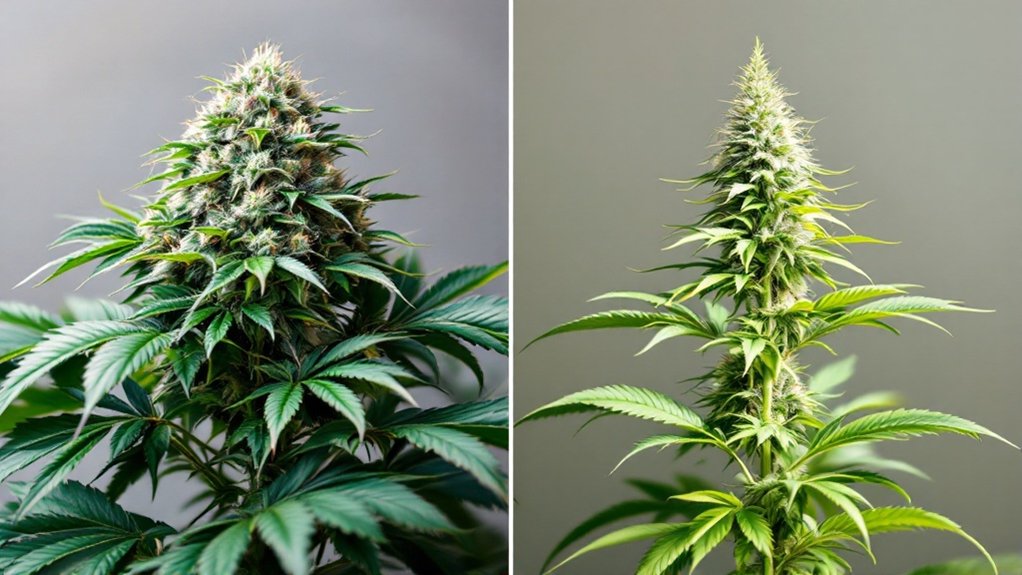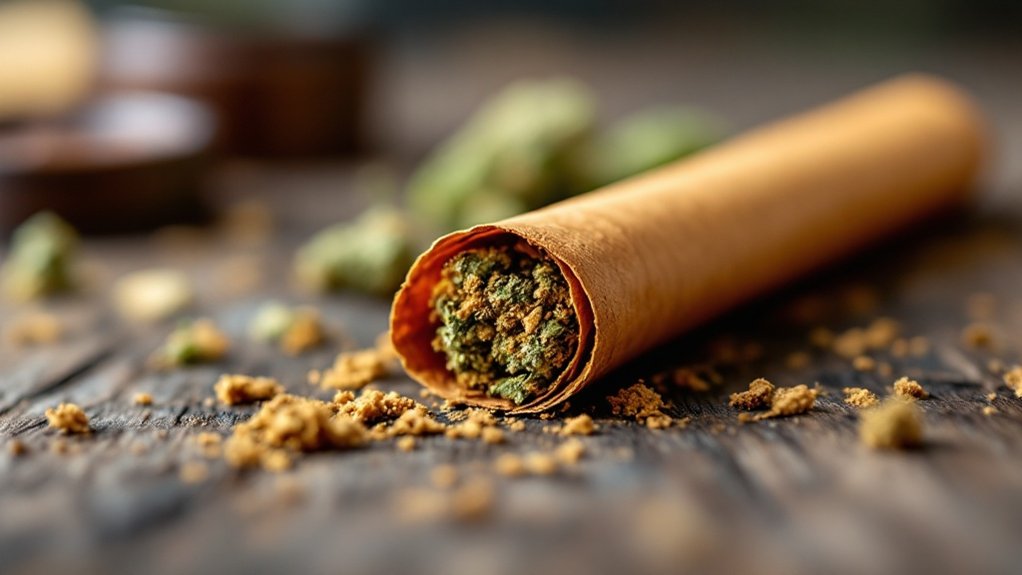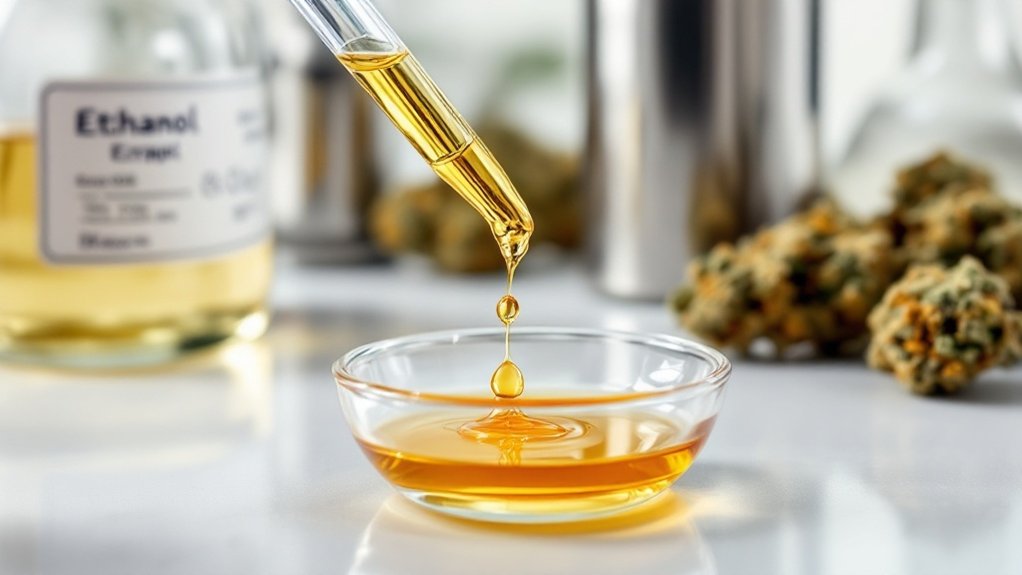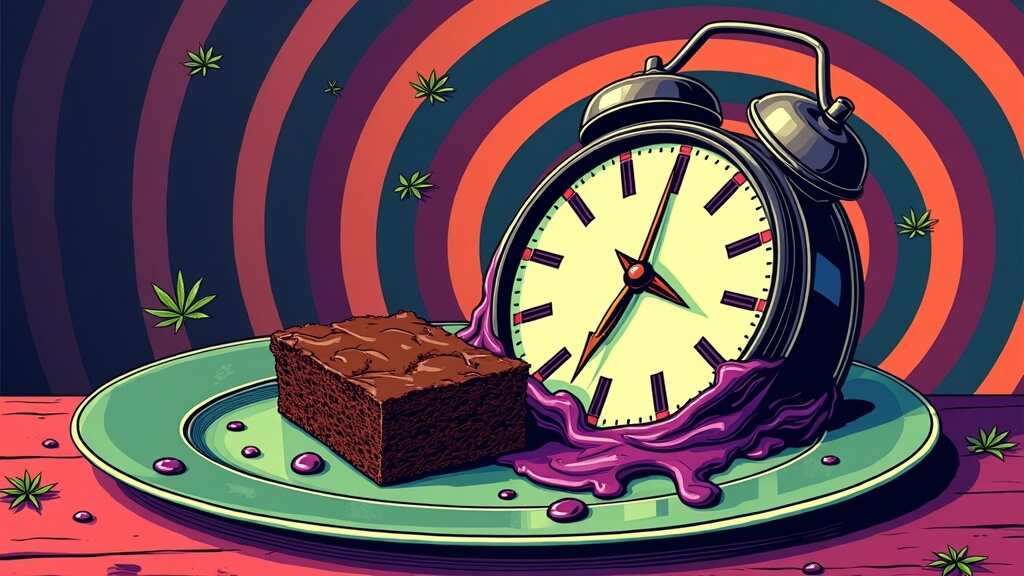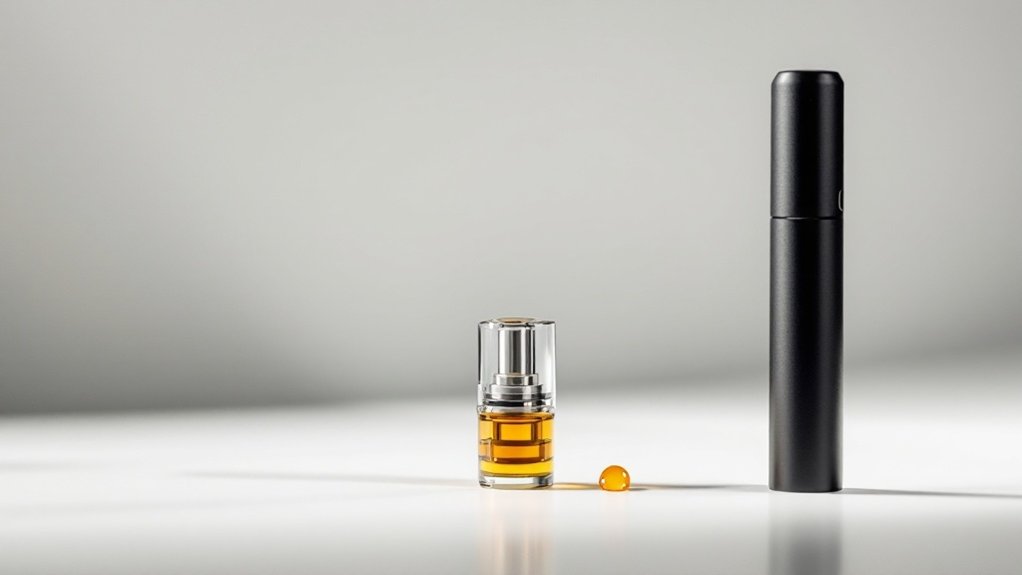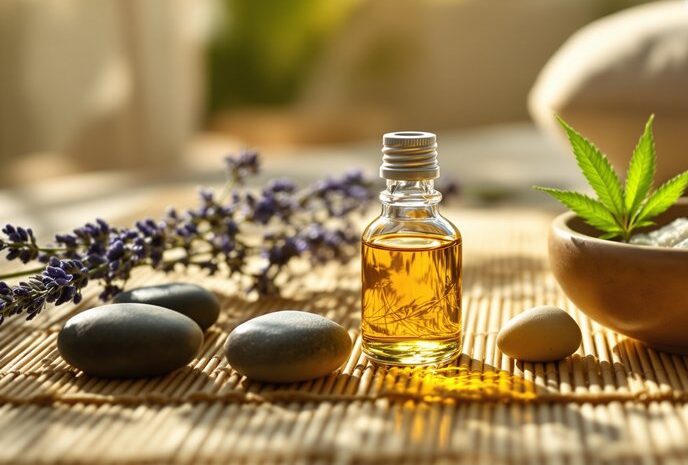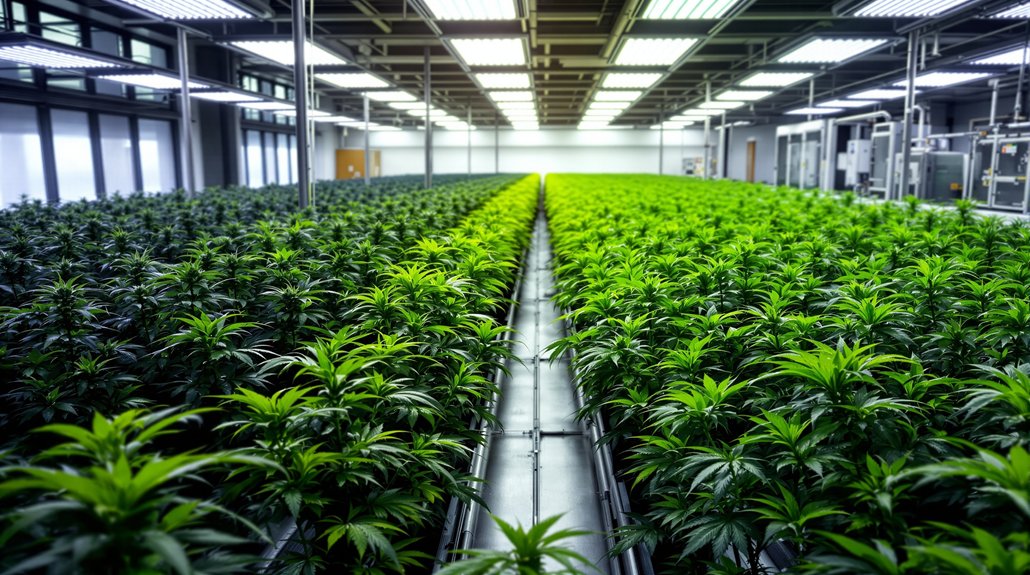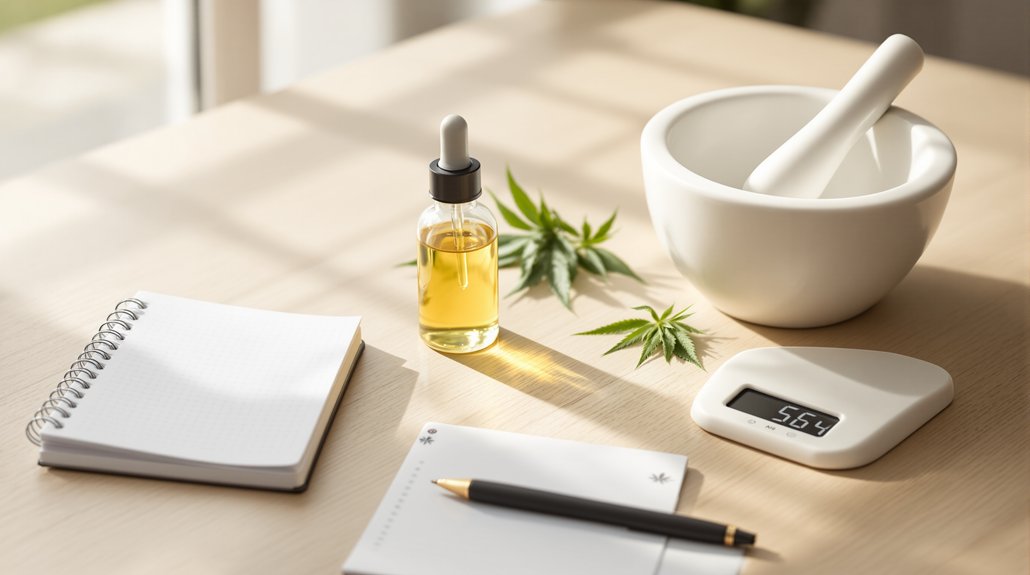Indica and sativa cannabis varieties differ dramatically in form and function. Indica plants – short, bushy natives of the Hindu Kush, deliver body-centered, sedative effects with higher CBD levels. Perfect for night use. Sativa, the lanky African and Asian variety, brings energetic, cerebral highs from higher THC content. Scientists, however, roll their eyes at this simplistic division. They insist terpene profiles matter more than these traditional categories. The chemical story goes deeper than plant shape.
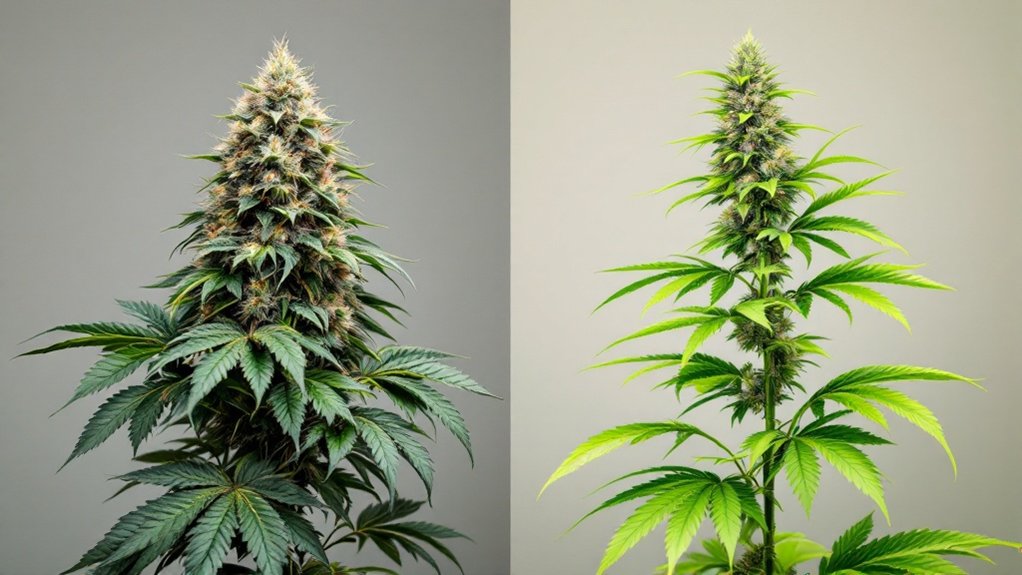
While cannabis enthusiasts often debate the merits of indica versus sativa strains, the differences between these two varieties extend far beyond casual conversation. These distinct cannabis types emerged from vastly different geographic origins, shaping their physical characteristics and traditional uses.
Indica developed in the harsh, dry climates of Afghanistan, Pakistan, India, and Turkey – specifically adapting to the Hindu Kush mountains. Sativa, meanwhile, flourishes in the warmer climates of Africa, Central America, and parts of Asia. When comparing strains, geography matters.
The cannabis family tree splits at geography’s crossroads – indica in Hindu Kush mountains, sativa in tropical paradises. Evolution by location.
The physical differences? Unmistakable. Indica plants are short, stocky little things with broad leaves and bushy growth. They mature quickly and produce buds faster.
Sativa plants? Totally different story. They grow tall – sometimes reaching 6 feet, with thin, light green leaves. They take their sweet time maturing. Not in a hurry, these plants.
Chemical composition varies greatly between the two. Indica generally contains higher CBD levels, though THC can be comparable to sativa strains. Sativa typically features higher THC with lower CBD content. Indica strains are often recognized by their skunky smell when consumed or handled. For patients seeking therapeutic benefits without intense psychoactive effects, Ruderalis varieties offer low THC and higher CBD concentrations.
But here’s the catch: wide variation exists within specific strains. The label doesn’t guarantee anything.
Effects follow predictable patterns, mostly. Indica delivers that classic “couch-lock” body high – deeply calming, often sedative. Perfect for nighttime use.
Sativa creates energizing, uplifting experiences that boost creativity and focus. Daytime favorite, for obvious reasons.
Some choose indica for managing pain, inducing sleep, or stimulating appetite. Sativa gets picked for enhancing productivity, mood elevation, or social situations. Hybrid strains? They’re the compromise candidates. Beyond these main categories, there are approximately 780 named strains in existence today, with new varieties constantly being developed.
Scientists, however, are rolling their eyes at these simplistic distinctions. Research shows cannabinoid and terpene profiles – not plant type determine effects.
The traditional indica/sativa classification focuses more on physical and historical differences than consistent chemical makeup. Anecdotal associations remain prevalent but scientifically oversimplified.
Bottom line: strain-specific analysis matters more than broad categorization. The debate continues.
Frequently Asked Questions
Which Is More Popular for Chronic Pain, Indica or Sativa?
For chronic pain sufferers, indica strains emerge as the clear favorite. A whopping 72% of indica users report choosing it for pain relief, compared to just 43% for sativa.
Why? Indica’s relaxing, sedative properties. Northern Lights and Granddaddy Purple lead the pack.
Sativa isn’t useless – some prefer it for daytime pain management without the drowsiness.
Bottom line: both work, but indica dominates the popularity contest. Science backs the preference.
How Do Hybrid Strains Compare to Pure Indica or Sativa?
Hybrid strains offer the best of both worlds.
They combine indica’s relaxing body effects with sativa’s cerebral stimulation in varying ratios. Unlike their purebred parents, hybrids can be customized for specific experiences – some leaning more sedative, others more energizing.
They’re engineered for balanced effects, unique cannabinoid profiles, and improved growing characteristics. For consumers seeking middle-ground experiences, hybrids deliver precisely calibrated effects.
They’re cannabis’s greatest hits album.
Can You Develop Tolerance to One Type More Than Another?
Tolerance development isn’t about indica or sativa classifications. It’s about THC content.
Users develop tolerance to cannabinoids themselves, not strain types. Sure, if you typically use high-THC sativas, you might build tolerance faster than someone using moderate THC indicas. But that’s correlation, not causation.
The endocannabinoid system doesn’t care about your fancy strain names. Frequency of use matters most.
Are There Legal Differences Between Indica and Sativa Strains?
Legal distinctions between indica and sativa? Not really. Laws care about THC content, not plant type.
Both varieties face identical restrictions based on cannabinoid profiles—not botanical classifications.
Cultivation might see different regulations simply because sativas tend to grow taller (up to 16 feet / 5 meters), while indicas stay compact.
Medical frameworks and marketing rules apply equally to both.
How Do Cultivation Requirements Differ Between Indica and Sativa Plants?
Sativas and indicas couldn’t be more different, cultivation-wise.
Sativas? Tall, lanky things. Need tons of vertical space, take forever to flower, and demand warm, humid conditions. Fussy about light, too.
Indicas? The low-maintenance siblings. Short, compact, and quick to mature – usually ready in 6-8 weeks.
They’ll handle temperature swings that would make a sativa wilt. Need more nutrients, though. Dense buds mean mold risks.
Choose your adventure, growers.
